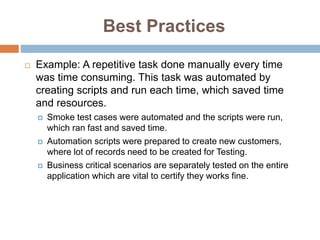Software testing Report
- 1. SOFTWARE TESTING REPORT Ahmed Maher Khalifa15 Mar, 2015
- 3. Test Reporting Test Reporting is the means of communicating the results of testing A final test report should be prepared at the conclusion of each test activity. The test reports are designed to document the results of testing as defined in the test plan. Without a well-developed test plan, it is difficult to develop a meaningful test report. A test report is designed to accomplished three objectives: Define the scope of testing: Normally a brief recap of the test plan Present the results of testing. Draw conclusions and make recommendations based on those results.
- 4. Example Assume that if the Client who sits in a remote location need to understand the results and status about a Testing project which was performed for a period of, say for example – four months Test Summary Report will solve the purpose.
- 5. Example Testing of ‘ABCD transport system’ application. ‘ABCD transport system’ is a web based Bus ticket booking application. Tickets for various buses can be booked using the online facilities. Real time passenger information is received from a ‘Central repository system’, which will be referred before booking is confirmed. There are several modules like Registration, Booking, Payment and Reports which are integrated to fulfill the purpose.
- 6. Testing Scope & Types of testing Testing Scope a) In Scope b) Out of Scope c) Items not tested Types of testing performed a) Smoke Testing b) System Integration Testing c) Regression Testing
- 7. Test Metrics Testing by itself has no value…but it produces potentially valuable information Test information must be generated and communicated effectively to be valuable Common communication goals Notify (“We have 24 bugs remaining to close”) Enlighten (“See the time lost due to reopens”) Influence (“We propose a bug triage meeting”) The metrics should be used as part of regular status reports (dashboards) as well as periodic analyses
- 8. How to Develop Metrics? Identify objectives Create questions about effectiveness, efficiency, and elegance of achievement of objectives Devise a measurable metric (or find a surrogate metric) to address the question Set a goal for each metric Implement improvements to enhance achievement of objectives Let’s look at two examples…
- 9. Bug Finding Effectiveness Objective: Finding bugs Question: What percentage of bugs found? Metric: Defect detection percentage Goal: A typical number is 85%, though some teams do much better presentbugs detectedbugs DDP bugsproductionbugstest bugstest )( testingforDDP
- 11. Test Environment & Lessons Learnt Test Environment & Tools Lessons Learnt
- 12. Best Practices Example: A repetitive task done manually every time was time consuming. This task was automated by creating scripts and run each time, which saved time and resources. Smoke test cases were automated and the scripts were run, which ran fast and saved time. Automation scripts were prepared to create new customers, where lot of records need to be created for Testing. Business critical scenarios are separately tested on the entire application which are vital to certify they works fine.
- 13. Exit Criteria All test cases should be executed – Yes All defects in Critical, Major, Medium severity should be verified and closed – Yes. Any open defects in trivial severity – Action plan prepared with expected dates of closure. Example: No Severity1 defects should be ‘OPEN’; Only 2 Severity2 defects should be ‘OPEN’; Only 4 Severity3 defects should be ‘OPEN’.
- 14. What Test Summary Report contains? A typical Test Report template will contain: 1. Purpose of the document 2. Application Overview 3. Testing Scope 4. Metrics 5. Types of testing performed 6. Test Environment & Tools 7. Lessons Learned 8. Recommendations 9. Best Practices 10.Exit Criteria 11.Conclusion/Sign Off ‘Go Live’ 12.Definitions, Acronyms, and Abbreviations
- 15. Questions ?
















